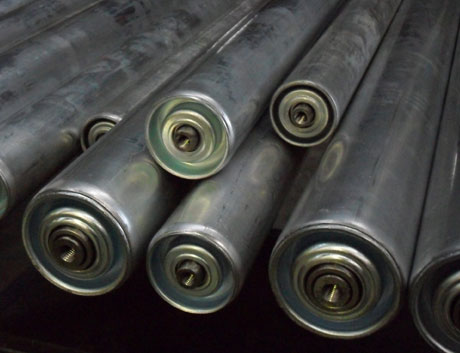
In the world of material handling, power roller conveyors play a pivotal role in moving goods efficiently within warehouses, manufacturing facilities, and distribution centers. These systems are essential for streamlining operations, improving productivity, and reducing manual labor. In this comprehensive guide, we’ll explore the intricacies of power roller conveyors, including their design, functionality, benefits, and maintenance tips.
1. What Are Power Roller Conveyors?
Power roller conveyors are mechanized systems designed to transport items along a conveyor belt using powered rollers. Unlike gravity conveyors, which rely solely on gravity and manual effort to move materials, power roller conveyors use an integrated power source, such as an electric motor, to drive the rollers and propel items forward. This automation enhances efficiency and allows for controlled movement of goods, making it ideal for various industrial applications.
2. Components of Power Roller Conveyors
To understand how power roller conveyors work, it’s important to familiarize yourself with their key components:
a. Rollers: The core element of a power roller conveyor is the rollers. These cylindrical components are mounted on a frame and are powered by a motor to move items along the conveyor. Rollers can be made from various materials, including steel, aluminum, and plastic, depending on the application and the type of goods being transported.
b. Drive System: The drive system consists of a motor and a series of gears, belts, or chains that transmit power to the rollers. This system ensures that the rollers turn at the appropriate speed to move the items efficiently.
c. Conveyor Frame: The frame provides structural support for the rollers and the entire conveyor system. It is usually constructed from metal or heavy-duty plastic and is designed to withstand the weight and movement of the goods being transported.
d. Supports and Stands: These components provide stability and support for the conveyor system. They are adjustable to accommodate different conveyor heights and ensure proper alignment of the rollers.
e. Controls: Controls include switches, sensors, and programmable logic controllers (PLCs) that regulate the conveyor’s operation. They allow operators to start, stop, and adjust the conveyor’s speed and direction.
f. Belts and Chains: In some power roller conveyors, belts or chains are used to connect the rollers to the drive system. These components help to synchronize the movement of the rollers and ensure smooth operation.
3. Types of Power Roller Conveyors
Power roller conveyors come in various types, each suited to different applications:
a. Line Shaft Conveyors: Line shaft conveyors use a continuous shaft running beneath the rollers to transmit power. This type of conveyor is cost-effective and easy to maintain, making it suitable for lightweight to medium-weight items.
b. Belt-Driven Roller Conveyors: Belt-driven roller conveyors use a belt that wraps around the rollers to transmit power. This design provides smooth and quiet operation and is ideal for applications requiring precise control of product movement.
c. Chain-Driven Roller Conveyors: Chain-driven roller conveyors use chains to drive the rollers. This type is suitable for heavy-duty applications and can handle larger and heavier loads compared to other types.
d. Accumulation Conveyors: Accumulation conveyors are designed to accumulate and buffer products without stopping the entire conveyor system. They use various methods, such as zone-based accumulation or pressure accumulation, to manage the flow of goods.
e. Zero Pressure Accumulation Conveyors: These conveyors are designed to ensure that products do not come into contact with each other while being transported. This minimizes damage and ensures that items are handled gently.
4. Benefits of Power Roller Conveyors
Power roller conveyors offer numerous advantages, making them a popular choice in various industries:
a. Increased Efficiency: Power roller conveyors automate the process of moving goods, which increases efficiency and speeds up operations. This reduces the need for manual labor and minimizes human error.
b. Enhanced Control: With integrated controls, operators can adjust the speed, direction, and operation of the conveyor system with precision. This level of control is crucial for handling different types of products and optimizing workflows.
c. Reduced Labor Costs: By automating material handling, power roller conveyors reduce the need for manual handling, which lowers labor costs and improves overall productivity.
d. Improved Safety: Power roller conveyors minimize the risk of injuries associated with manual handling and reduce the likelihood of product damage due to mishandling.
e. Versatility: These conveyors can be customized to handle a wide range of products, including boxes, pallets, and packages of various sizes and weights. They can also be integrated with other systems, such as sorting and packaging equipment.
5. Applications of Power Roller Conveyors
Power roller conveyors are used in a variety of applications across different industries:
a. Warehousing and Distribution: In warehouses and distribution centers, power roller conveyors efficiently move products from receiving areas to storage locations or shipping zones. They help streamline order fulfillment and improve inventory management.
b. Manufacturing: In manufacturing facilities, power roller conveyors transport materials between production stages, such as assembly lines, packing stations, and quality control areas.
c. Retail: Retailers use power roller conveyors to manage the flow of products from the stockroom to the sales floor, improving restocking efficiency and inventory accuracy.
d. Food and Beverage: In the food and beverage industry, power roller conveyors are used to transport packaged goods through processing, packaging, and distribution stages while maintaining hygiene standards.
e. Automotive: Automotive manufacturers use power roller conveyors to move parts and assemblies through various stages of production, from assembly lines to quality testing.
6. Maintenance and Troubleshooting
To ensure the optimal performance of power roller conveyors, regular maintenance and troubleshooting are essential:
a. Routine Inspections: Conduct regular inspections of the conveyor system to identify any signs of wear or damage. Check the rollers, drive system, and controls for any issues that may affect performance.
b. Lubrication: Keep the drive system and bearings well-lubricated to reduce friction and prevent premature wear. Follow the manufacturer’s recommendations for lubrication intervals and types of lubricants.
c. Cleanliness: Maintain a clean conveyor system to prevent debris and contaminants from interfering with the rollers and drive system. Regular cleaning helps to ensure smooth operation and prolongs the life of the components.
d. Alignment and Adjustment: Check the alignment of the rollers and ensure that they are properly adjusted. Misalignment can cause uneven wear and reduce the efficiency of the conveyor system.
e. Troubleshooting Common Issues: Address common issues such as roller jams, motor malfunctions, and belt or chain slippage promptly. Refer to the manufacturer’s troubleshooting guide for specific solutions to common problems.
7. Conclusion
Power roller conveyors are a vital component of modern material handling systems, offering numerous benefits in terms of efficiency, control, and safety. By understanding the components, types, and applications of power roller conveyors, as well as adhering to proper maintenance practices, businesses can optimize their operations and ensure the smooth flow of goods through their facilities. Whether you’re in warehousing, manufacturing, or retail, investing in a well-designed power roller conveyor system can significantly enhance productivity and streamline your material handling processes.





